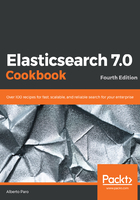
Managing Mapping
Mapping is a very important concept in Elasticsearch, as it defines how the search engine should process a document and its fields.
Search engines perform the following two main operations:
- Indexing: This is the action to receive a document and to process it and store it in an index
- Searching: This is the action to retrieve the data from the index
These two parts are strictly connected; an error in the indexing step leads to unwanted or missing search results.
Elasticsearch has explicit mapping on an index level. When indexing, if a mapping is not provided, a default one is created, and guesses the structure from the data fields that the document is composed of. This new mapping is then automatically propagated to all cluster nodes.
The default type mapping has sensible default values, but when you want to change their behavior or customize several other aspects of indexing (storing, ignoring, completion, and so on), you need to provide a new mapping definition.
In this chapter, we'll look at all possible mapping field types that document mappings are composed of.
This chapter will cover the following recipes:
- Using explicit mapping creation
- Mapping base types
- Mapping arrays
- Mapping an object
- Mapping a document
- Using dynamic templates in document mapping
- Managing nested objects
- Managing a child document with a join field
- Adding a field with multiple mappings
- Mapping a GeoPoint field
- Mapping a GeoShape field
- Mapping an IP field
- Mapping an alias field
- Mapping a Percolator field
- Mapping feature and feature vector fields
- Adding metadata to a mapping
- Specifying a different analyzers
- Mapping a completion field